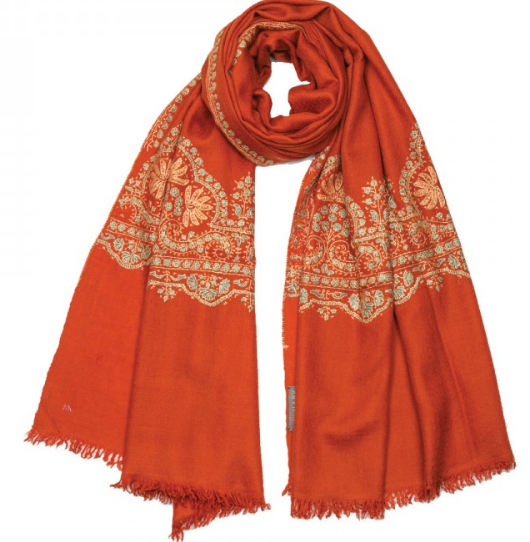Kashmiri shawls are soft to the touch and wonderfully graceful to wear, conveying the greatest talents of Kashmiri artisans while also displaying the refined aesthetic of their users. It is considered that no other shawl surpasses in colour, design, beauty, hand embroideries, and texture the legendary Kashmiri shawls.
Hand Embroidery Styles for Kashmiri pashmina shawl
Depending on the underlying fabric, a variety of hand embroidery is done on Kashmiri shawls.
Sozni Embroidery
Pashmina is handwoven and so fine and delicate enough to shred if handled roughly. As a result, the finest embroidery for these beauties is Sozni Kari. After weaving the shawl, a Naqash utilizes block prints to create the contour of the design, which is generally a traditional design. These motifs have evolved from the Mughals’ introduction of Persian-inspired Paisley, floral patterns that blossom in the valley itself in the spring and summer, and many others. Colour can be chosen by embroidery craftsmen for a specific shawl. They have decades of knowledge and choose a complementary hue based on the base colour, which is inspired by current fashion trends.
Sozni mostly employs cotton threads, but silk is also used on occasion. Embroidery motifs onto the gossamer substrate are done with fine needles. The quantity of needlework to be done on the shawl determines how long it will take to complete. Jaali shawls are lighter, whereas tuki Jama is thick with needlework designs. Tuki Jama shawls can take years to make.
Papier-Mache Embroidery
Papier Mache embroidery, also known as Paper Mache embroidery, is a stronger variation of Sozni needlework. It is made up of stunning designs that are stitched in a brightly coloured satin thread. Motifs are outlined in black to give them a projecting appearance.
Papier Mache creates a more attractive visual impact by using thicker needles and thread.
Tilla Embroidery
Tilla embroidery is a type of needlework that makes the Kashmiri pashmina shawl relatively pricey. This style is so popular in the valley that every bride’s trousseau should include at least one phiran (a garment worn by Kashmiri women) embroidered with tilla embroidery. Onlookers are expecting a shawl ornately embroidered with Tilla.
Tilla is from the Iranian village of “Zari.” However, when Sufi saint Syed Ali Hamdani travelled to Kashmir with his craftsmen, he introduced the same to the local society. The then-ruling Mughals were enthralled by its princely demeanor and utilized it in their imperial courts.
Kalamkari Embroidery
Kalamkari patterns on the Kashmiri pashmina shawl are not needlework in the traditional sense. However, sozni stitching is done afterward, over the hand-painted designs. Kalamkari is derived from two words: ‘kalam,’ which means ‘pen,’ and ‘Kari,’ which means ‘labour.’ As a result, Kalamkari refers to pen work. Bamboo is used to make the pens used in Kalamkari. Natural dyes are utilized to create the colours. The skill of painting over shawls is quite hard, requiring up to 20 phases to complete. The finished product is incredibly crafted and very lovely.
Aari Embroidery
Aari needlework, also known as Kashida Kari, is done on Raffal shawls, which are made of sheep wool. Aari stitching uses a unique crooked head hook known as an “aari” rather than a needle to embroider. Using a hook saves time since it pulls numerous loops of thread at once. The needle, on the other hand, accomplishes the same thing one by one.

